air suspension FORD SUPER DUTY 2023 Owners Manual
[x] Cancel search | Manufacturer: FORD, Model Year: 2023, Model line: SUPER DUTY, Model: FORD SUPER DUTY 2023Pages: 738, PDF Size: 18.49 MB
Page 352 of 738

WHAT IS SPEED SIGN
RECOGNITION
Speed sign recognition detects speed limitsigns to inform you of the current speedlimit. Detected speed signs appear in theinstrument cluster display.
HOW DOES SPEED SIGN
RECOGNITION WORK
Speed sign recognition uses a sensorbehind the interior mirror to detect speedsigns.
If your vehicle has speed sign recognitionwith navigation, stored speed sign datamay influence the indicated speed limitvalue.
SPEED SIGN RECOGNITION
PRECAUTIONS
WARNING: You are responsible forcontrolling your vehicle at all times. Thesystem is designed to be an aid and doesnot relieve you of your responsibility todrive with due care and attention. Failureto follow this instruction could result inthe loss of control of your vehicle,personal injury or death.
WARNING: In cold and severeweather conditions the system may notfunction. Rain, snow and spray can alllimit sensor performance.
WARNING: The system may notoperate properly if the sensor is blocked.Keep the windshield free fromobstruction.
Note:Do not carry out windshield repairsin the immediate area surrounding thesensor.
Note:If your vehicle has a suspension kitnot approved by Ford, the system may notcorrectly function.
Note:The system may not detect all speedsigns and may incorrectly read signs.
Note:Always fit our original parts whenreplacing headlamp bulbs. Other bulbs mayreduce system performance.
SPEED SIGN RECOGNITION
LIMITATIONS
Speed sign recognition may not operatecorrectly due to:
•Outdated map data.
•Incorrect recognition of speed limits bythe sensor of signs on parallel roads orexit ramps.
•Missed recognition of faded, dirty, ordistorted signs.
SPEED SIGN RECOGNITION
INDICATORS
When the system detects a speed limitsign, it appears in the instrument clusterdisplay.
348
2023 Super Duty (TFH) Canada/United States of America, enUSA, Edition date: 202211, DOMSpeed Sign Recognition (If Equipped)E317824
Page 418 of 738
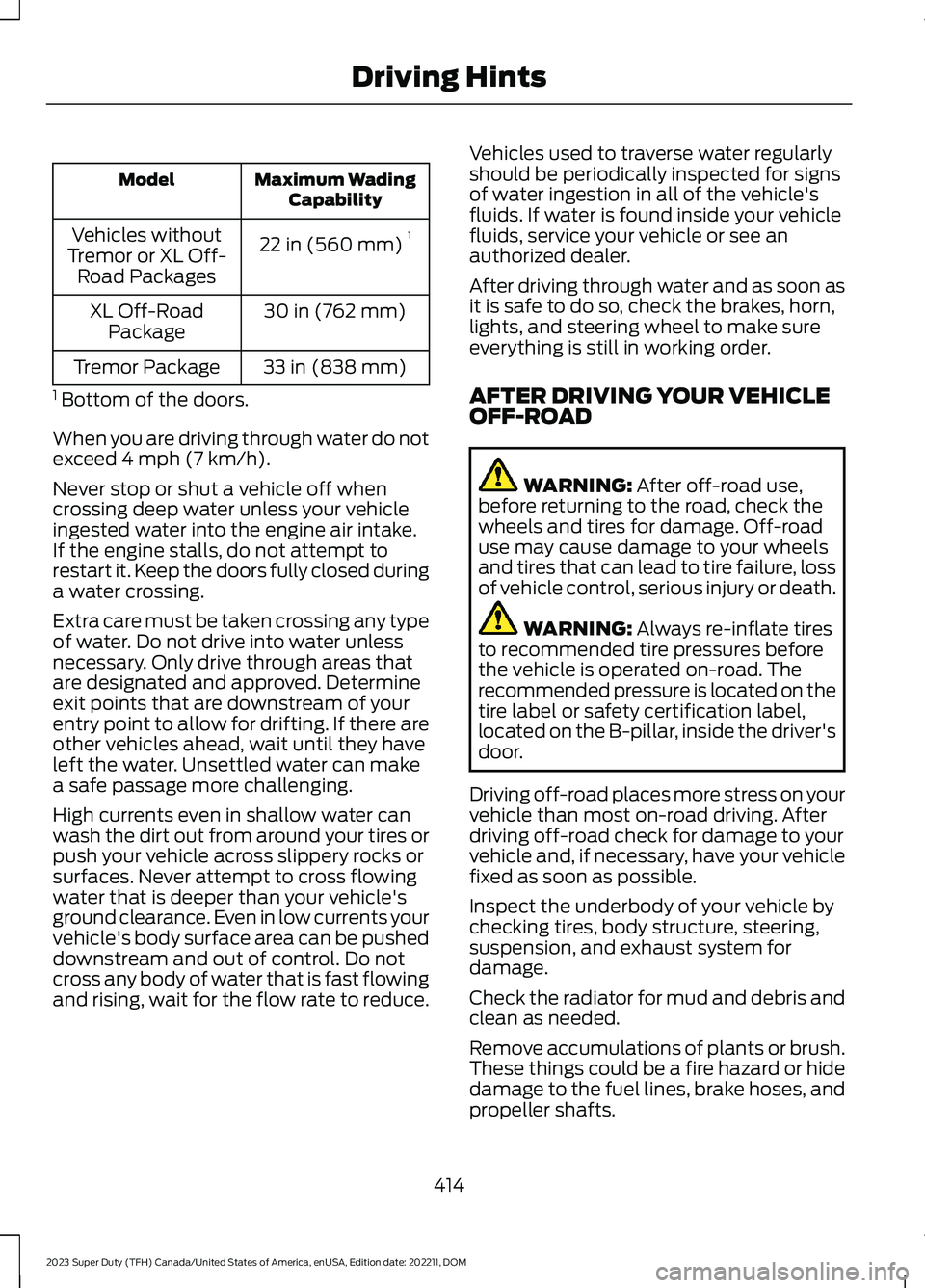
Maximum WadingCapabilityModel
22 in (560 mm)1Vehicles withoutTremor or XL Off-Road Packages
30 in (762 mm)XL Off-RoadPackage
33 in (838 mm)Tremor Package
1 Bottom of the doors.
When you are driving through water do notexceed 4 mph (7 km/h).
Never stop or shut a vehicle off whencrossing deep water unless your vehicleingested water into the engine air intake.If the engine stalls, do not attempt torestart it. Keep the doors fully closed duringa water crossing.
Extra care must be taken crossing any typeof water. Do not drive into water unlessnecessary. Only drive through areas thatare designated and approved. Determineexit points that are downstream of yourentry point to allow for drifting. If there areother vehicles ahead, wait until they haveleft the water. Unsettled water can makea safe passage more challenging.
High currents even in shallow water canwash the dirt out from around your tires orpush your vehicle across slippery rocks orsurfaces. Never attempt to cross flowingwater that is deeper than your vehicle'sground clearance. Even in low currents yourvehicle's body surface area can be pusheddownstream and out of control. Do notcross any body of water that is fast flowingand rising, wait for the flow rate to reduce.
Vehicles used to traverse water regularlyshould be periodically inspected for signsof water ingestion in all of the vehicle'sfluids. If water is found inside your vehiclefluids, service your vehicle or see anauthorized dealer.
After driving through water and as soon asit is safe to do so, check the brakes, horn,lights, and steering wheel to make sureeverything is still in working order.
AFTER DRIVING YOUR VEHICLEOFF-ROAD
WARNING: After off-road use,before returning to the road, check thewheels and tires for damage. Off-roaduse may cause damage to your wheelsand tires that can lead to tire failure, lossof vehicle control, serious injury or death.
WARNING: Always re-inflate tiresto recommended tire pressures beforethe vehicle is operated on-road. Therecommended pressure is located on thetire label or safety certification label,located on the B-pillar, inside the driver'sdoor.
Driving off-road places more stress on yourvehicle than most on-road driving. Afterdriving off-road check for damage to yourvehicle and, if necessary, have your vehiclefixed as soon as possible.
Inspect the underbody of your vehicle bychecking tires, body structure, steering,suspension, and exhaust system fordamage.
Check the radiator for mud and debris andclean as needed.
Remove accumulations of plants or brush.These things could be a fire hazard or hidedamage to the fuel lines, brake hoses, andpropeller shafts.
414
2023 Super Duty (TFH) Canada/United States of America, enUSA, Edition date: 202211, DOMDriving Hints
Page 476 of 738
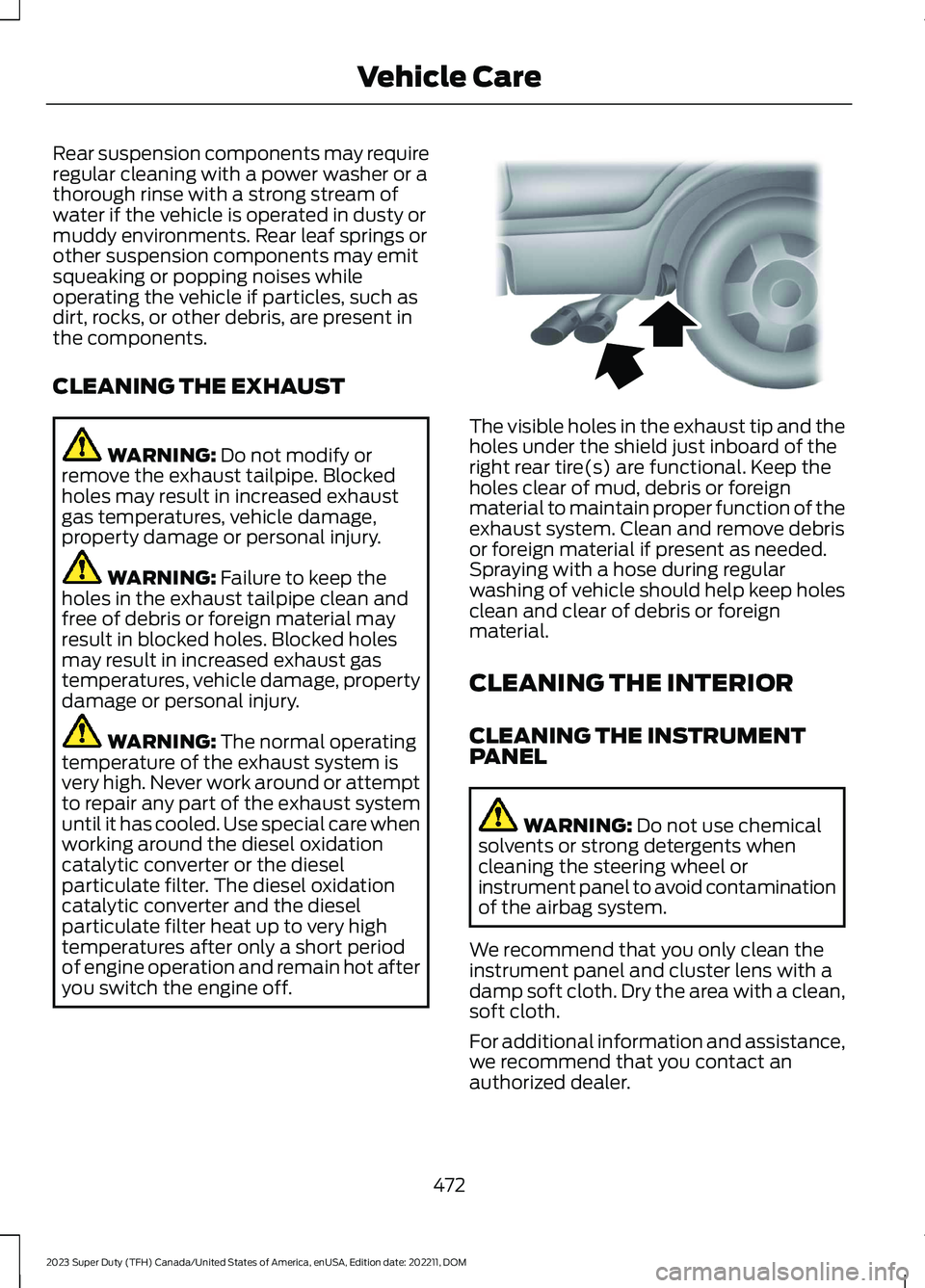
Rear suspension components may requireregular cleaning with a power washer or athorough rinse with a strong stream ofwater if the vehicle is operated in dusty ormuddy environments. Rear leaf springs orother suspension components may emitsqueaking or popping noises whileoperating the vehicle if particles, such asdirt, rocks, or other debris, are present inthe components.
CLEANING THE EXHAUST
WARNING: Do not modify orremove the exhaust tailpipe. Blockedholes may result in increased exhaustgas temperatures, vehicle damage,property damage or personal injury.
WARNING: Failure to keep theholes in the exhaust tailpipe clean andfree of debris or foreign material mayresult in blocked holes. Blocked holesmay result in increased exhaust gastemperatures, vehicle damage, propertydamage or personal injury.
WARNING: The normal operatingtemperature of the exhaust system isvery high. Never work around or attemptto repair any part of the exhaust systemuntil it has cooled. Use special care whenworking around the diesel oxidationcatalytic converter or the dieselparticulate filter. The diesel oxidationcatalytic converter and the dieselparticulate filter heat up to very hightemperatures after only a short periodof engine operation and remain hot afteryou switch the engine off.
The visible holes in the exhaust tip and theholes under the shield just inboard of theright rear tire(s) are functional. Keep theholes clear of mud, debris or foreignmaterial to maintain proper function of theexhaust system. Clean and remove debrisor foreign material if present as needed.Spraying with a hose during regularwashing of vehicle should help keep holesclean and clear of debris or foreignmaterial.
CLEANING THE INTERIOR
CLEANING THE INSTRUMENTPANEL
WARNING: Do not use chemicalsolvents or strong detergents whencleaning the steering wheel orinstrument panel to avoid contaminationof the airbag system.
We recommend that you only clean theinstrument panel and cluster lens with adamp soft cloth. Dry the area with a clean,soft cloth.
For additional information and assistance,we recommend that you contact anauthorized dealer.
472
2023 Super Duty (TFH) Canada/United States of America, enUSA, Edition date: 202211, DOMVehicle CareE163380
Page 492 of 738

cause steering, suspension, axle, transfercase or power transfer unit failure.Follow the recommended tire inflationpressures found on the SafetyCompliance Certification label, or theTire Label on the B-Pillar or the edge ofthe driver door. Failure to follow thisinstruction could result in loss of vehiclecontrol, vehicle rollover, or personal injuryor death.
Note:Do not use snow chains on vehicleswith LT275/65R20 or LT 285/75R18 sizedtires.
Note:The suspension insulation andbumpers will help prevent vehicle damage.Do not remove these components from yourvehicle when using snow tires and chains.
The tires on your vehicle have all-weathertreads to provide traction in rain and snow.However, in some climates, you may needto use snow tires and cables. If you needto use cables, we recommend that you usesteel wheels of the same size andspecification, as cables may chipaluminum wheels.
Follow these guidelines when using snowtires and chains:
•If possible, avoid fully loading yourvehicle.
•Use only SAE Class S chains.
•Install chains securely, verifying thatthe chains do not touch any wiring,brake lines or fuel lines.
•Only install snow chains on the rearaxle.
•For Dual Rear Wheel (DRW) vehicles,only install snow chains on the outerwheel of each pair.
•Drive cautiously. If you hear the chainsrub or bang against your vehicle, stopand retighten the chains. If this doesnot work, remove the chains to preventdamage to your vehicle.
•Remove the tire chains when you nolonger need them. Do not use tirechains on dry roads.
488
2023 Super Duty (TFH) Canada/United States of America, enUSA, Edition date: 202211, DOMWheel and Tire InformationE292547
Page 597 of 738
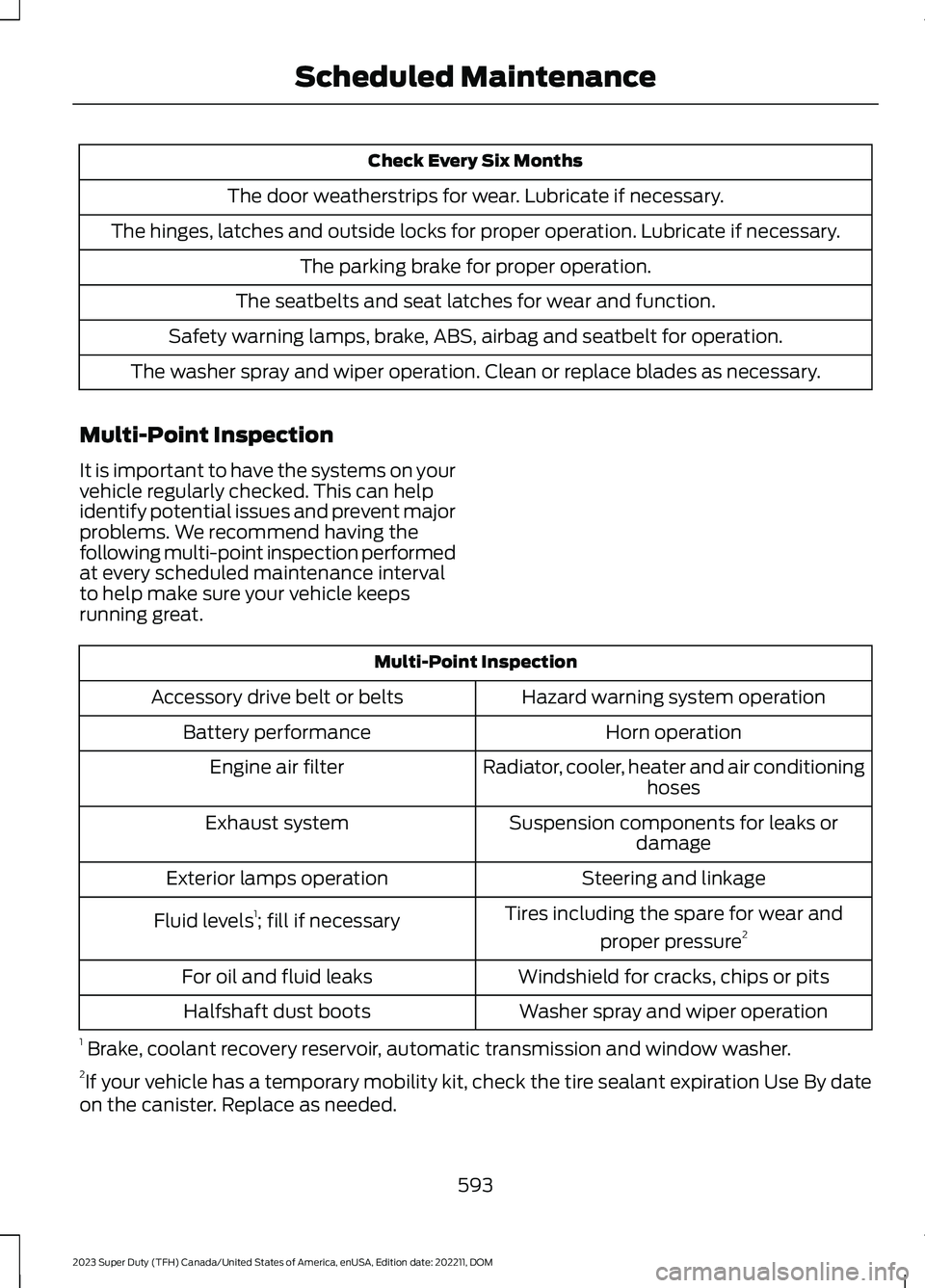
Check Every Six Months
The door weatherstrips for wear. Lubricate if necessary.
The hinges, latches and outside locks for proper operation. Lubricate if necessary.
The parking brake for proper operation.
The seatbelts and seat latches for wear and function.
Safety warning lamps, brake, ABS, airbag and seatbelt for operation.
The washer spray and wiper operation. Clean or replace blades as necessary.
Multi-Point Inspection
It is important to have the systems on yourvehicle regularly checked. This can helpidentify potential issues and prevent majorproblems. We recommend having thefollowing multi-point inspection performedat every scheduled maintenance intervalto help make sure your vehicle keepsrunning great.
Multi-Point Inspection
Hazard warning system operationAccessory drive belt or belts
Horn operationBattery performance
Radiator, cooler, heater and air conditioninghosesEngine air filter
Suspension components for leaks ordamageExhaust system
Steering and linkageExterior lamps operation
Tires including the spare for wear and
proper pressure2Fluid levels1; fill if necessary
Windshield for cracks, chips or pitsFor oil and fluid leaks
Washer spray and wiper operationHalfshaft dust boots
1 Brake, coolant recovery reservoir, automatic transmission and window washer.2If your vehicle has a temporary mobility kit, check the tire sealant expiration Use By dateon the canister. Replace as needed.
593
2023 Super Duty (TFH) Canada/United States of America, enUSA, Edition date: 202211, DOMScheduled Maintenance
Page 603 of 738
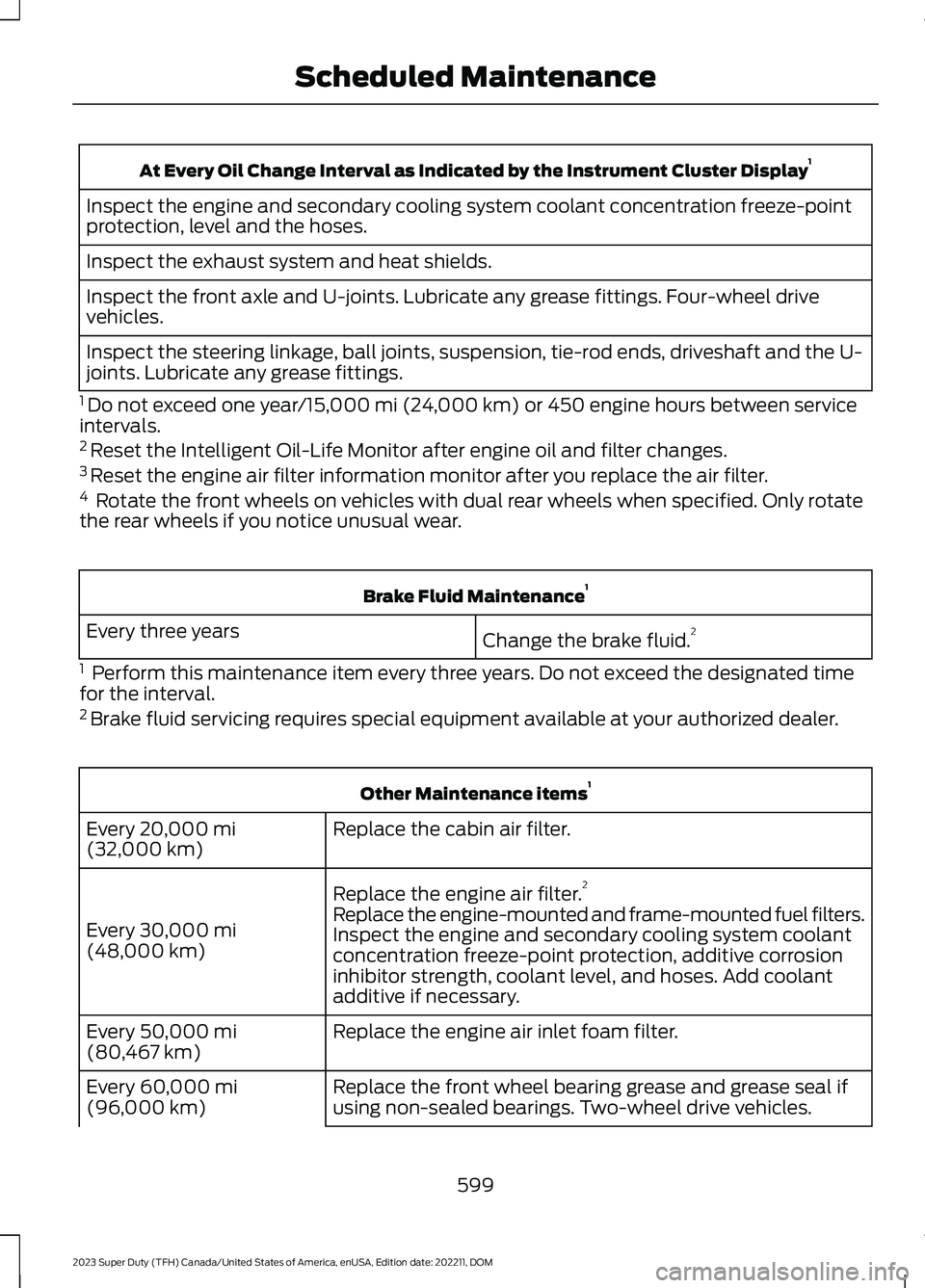
At Every Oil Change Interval as Indicated by the Instrument Cluster Display1
Inspect the engine and secondary cooling system coolant concentration freeze-pointprotection, level and the hoses.
Inspect the exhaust system and heat shields.
Inspect the front axle and U-joints. Lubricate any grease fittings. Four-wheel drivevehicles.
Inspect the steering linkage, ball joints, suspension, tie-rod ends, driveshaft and the U-joints. Lubricate any grease fittings.
1 Do not exceed one year/15,000 mi (24,000 km) or 450 engine hours between serviceintervals.2 Reset the Intelligent Oil-Life Monitor after engine oil and filter changes.3 Reset the engine air filter information monitor after you replace the air filter.4 Rotate the front wheels on vehicles with dual rear wheels when specified. Only rotatethe rear wheels if you notice unusual wear.
Brake Fluid Maintenance1
Change the brake fluid.2Every three years
1 Perform this maintenance item every three years. Do not exceed the designated timefor the interval.2 Brake fluid servicing requires special equipment available at your authorized dealer.
Other Maintenance items1
Replace the cabin air filter.Every 20,000 mi(32,000 km)
Replace the engine air filter.2
Every 30,000 mi(48,000 km)
Replace the engine-mounted and frame-mounted fuel filters.Inspect the engine and secondary cooling system coolantconcentration freeze-point protection, additive corrosioninhibitor strength, coolant level, and hoses. Add coolantadditive if necessary.
Replace the engine air inlet foam filter.Every 50,000 mi(80,467 km)
Replace the front wheel bearing grease and grease seal ifusing non-sealed bearings. Two-wheel drive vehicles.Every 60,000 mi(96,000 km)
599
2023 Super Duty (TFH) Canada/United States of America, enUSA, Edition date: 202211, DOMScheduled Maintenance
Page 606 of 738
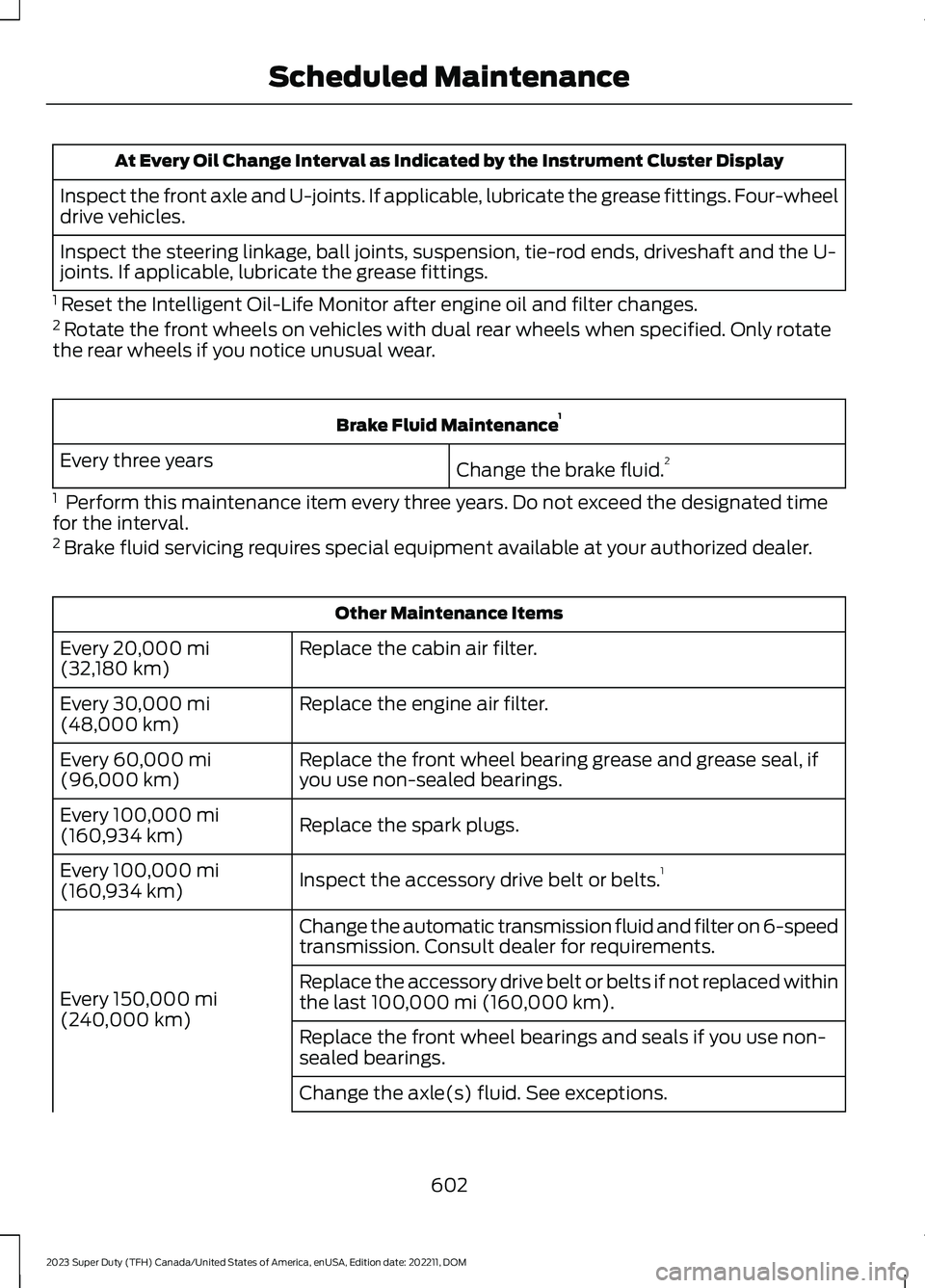
At Every Oil Change Interval as Indicated by the Instrument Cluster Display
Inspect the front axle and U-joints. If applicable, lubricate the grease fittings. Four-wheeldrive vehicles.
Inspect the steering linkage, ball joints, suspension, tie-rod ends, driveshaft and the U-joints. If applicable, lubricate the grease fittings.
1 Reset the Intelligent Oil-Life Monitor after engine oil and filter changes.2 Rotate the front wheels on vehicles with dual rear wheels when specified. Only rotatethe rear wheels if you notice unusual wear.
Brake Fluid Maintenance1
Change the brake fluid.2Every three years
1 Perform this maintenance item every three years. Do not exceed the designated timefor the interval.2 Brake fluid servicing requires special equipment available at your authorized dealer.
Other Maintenance Items
Replace the cabin air filter.Every 20,000 mi(32,180 km)
Replace the engine air filter.Every 30,000 mi(48,000 km)
Replace the front wheel bearing grease and grease seal, ifyou use non-sealed bearings.Every 60,000 mi(96,000 km)
Replace the spark plugs.Every 100,000 mi(160,934 km)
Inspect the accessory drive belt or belts.1Every 100,000 mi(160,934 km)
Change the automatic transmission fluid and filter on 6-speedtransmission. Consult dealer for requirements.
Every 150,000 mi(240,000 km)
Replace the accessory drive belt or belts if not replaced withinthe last 100,000 mi (160,000 km).
Replace the front wheel bearings and seals if you use non-sealed bearings.
Change the axle(s) fluid. See exceptions.
602
2023 Super Duty (TFH) Canada/United States of America, enUSA, Edition date: 202211, DOMScheduled Maintenance
Page 609 of 738
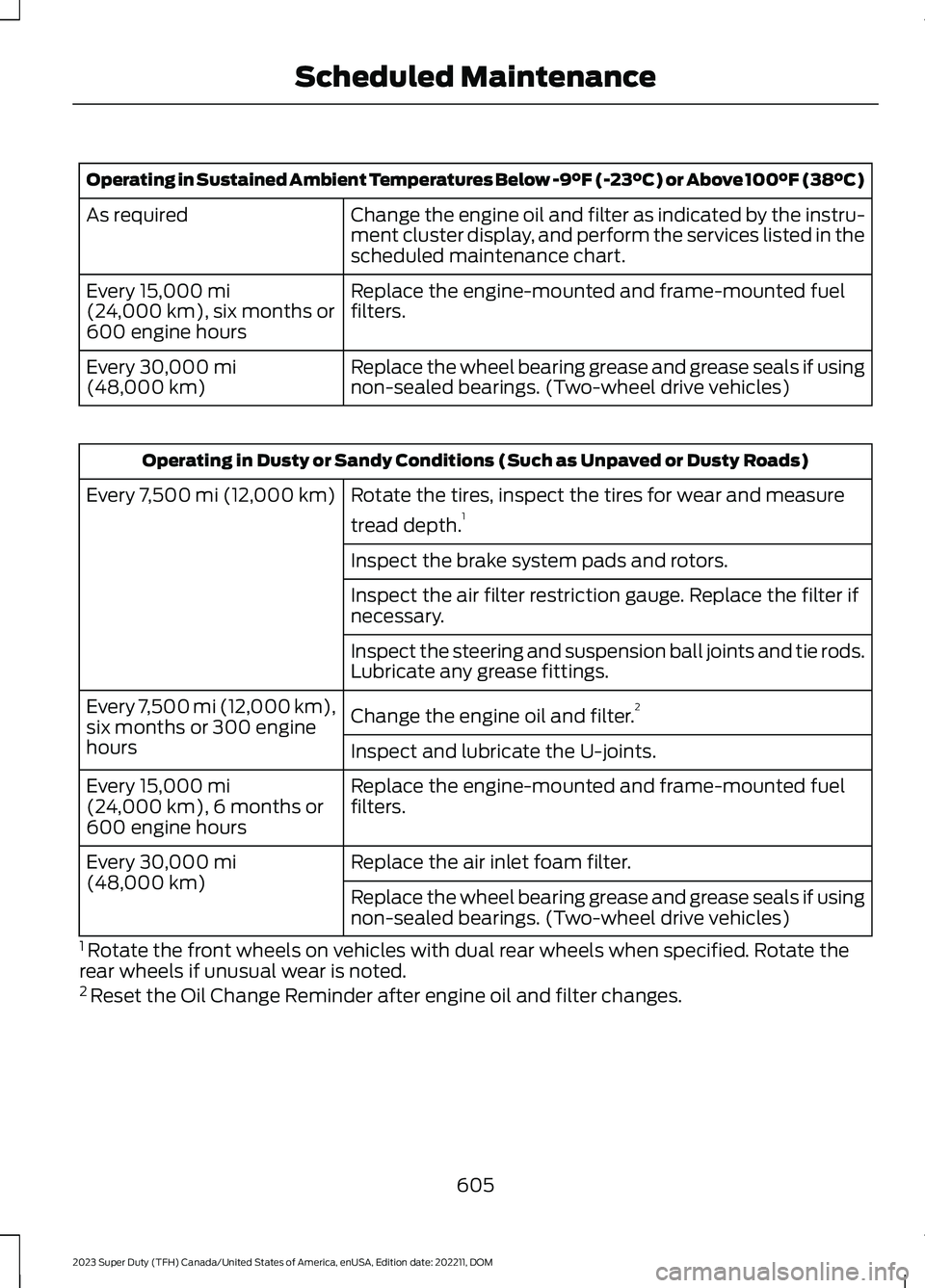
Operating in Sustained Ambient Temperatures Below -9°F (-23°C) or Above 100°F (38°C)
Change the engine oil and filter as indicated by the instru-ment cluster display, and perform the services listed in thescheduled maintenance chart.
As required
Replace the engine-mounted and frame-mounted fuelfilters.Every 15,000 mi(24,000 km), six months or600 engine hours
Replace the wheel bearing grease and grease seals if usingnon-sealed bearings. (Two-wheel drive vehicles)Every 30,000 mi(48,000 km)
Operating in Dusty or Sandy Conditions (Such as Unpaved or Dusty Roads)
Rotate the tires, inspect the tires for wear and measure
tread depth.1Every 7,500 mi (12,000 km)
Inspect the brake system pads and rotors.
Inspect the air filter restriction gauge. Replace the filter ifnecessary.
Inspect the steering and suspension ball joints and tie rods.Lubricate any grease fittings.
Change the engine oil and filter.2Every 7,500 mi (12,000 km),six months or 300 enginehoursInspect and lubricate the U-joints.
Replace the engine-mounted and frame-mounted fuelfilters.Every 15,000 mi(24,000 km), 6 months or600 engine hours
Replace the air inlet foam filter.Every 30,000 mi(48,000 km)Replace the wheel bearing grease and grease seals if usingnon-sealed bearings. (Two-wheel drive vehicles)
1 Rotate the front wheels on vehicles with dual rear wheels when specified. Rotate therear wheels if unusual wear is noted.2 Reset the Oil Change Reminder after engine oil and filter changes.
605
2023 Super Duty (TFH) Canada/United States of America, enUSA, Edition date: 202211, DOMScheduled Maintenance
Page 610 of 738
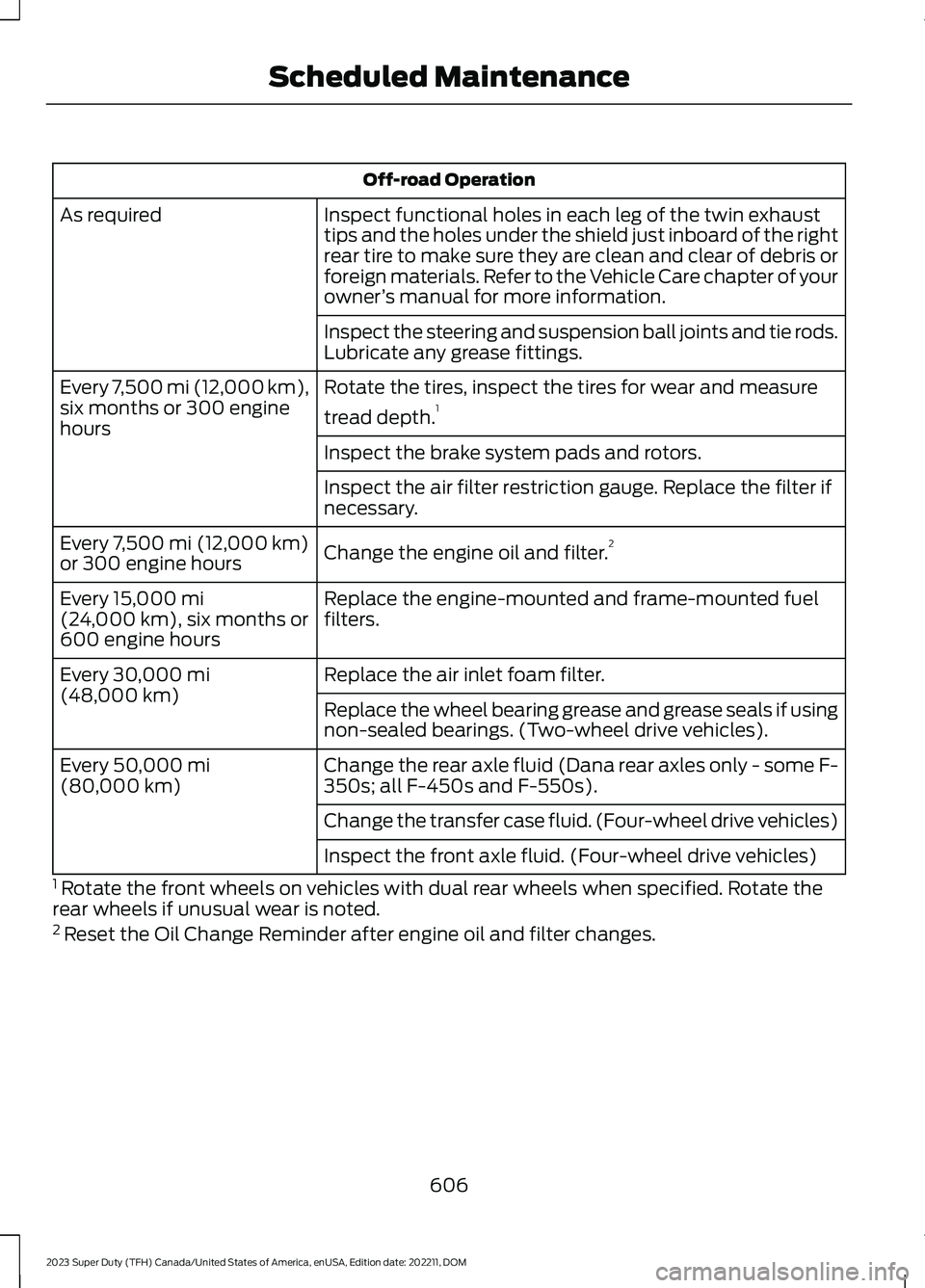
Off-road Operation
Inspect functional holes in each leg of the twin exhausttips and the holes under the shield just inboard of the rightrear tire to make sure they are clean and clear of debris orforeign materials. Refer to the Vehicle Care chapter of yourowner’s manual for more information.
As required
Inspect the steering and suspension ball joints and tie rods.Lubricate any grease fittings.
Rotate the tires, inspect the tires for wear and measure
tread depth.1Every 7,500 mi (12,000 km),six months or 300 enginehours
Inspect the brake system pads and rotors.
Inspect the air filter restriction gauge. Replace the filter ifnecessary.
Change the engine oil and filter.2Every 7,500 mi (12,000 km)or 300 engine hours
Replace the engine-mounted and frame-mounted fuelfilters.Every 15,000 mi(24,000 km), six months or600 engine hours
Replace the air inlet foam filter.Every 30,000 mi(48,000 km)Replace the wheel bearing grease and grease seals if usingnon-sealed bearings. (Two-wheel drive vehicles).
Change the rear axle fluid (Dana rear axles only - some F-350s; all F-450s and F-550s).Every 50,000 mi(80,000 km)
Change the transfer case fluid. (Four-wheel drive vehicles)
Inspect the front axle fluid. (Four-wheel drive vehicles)
1 Rotate the front wheels on vehicles with dual rear wheels when specified. Rotate therear wheels if unusual wear is noted.2 Reset the Oil Change Reminder after engine oil and filter changes.
606
2023 Super Duty (TFH) Canada/United States of America, enUSA, Edition date: 202211, DOMScheduled Maintenance